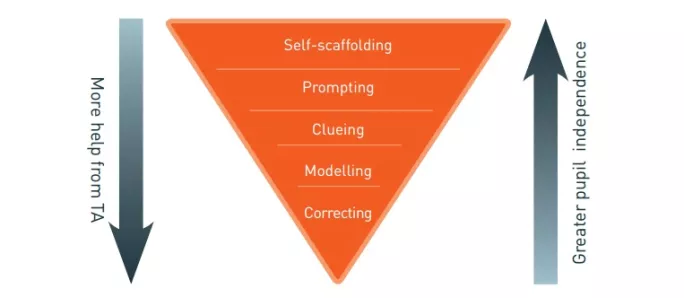The evidence couldn’t be clearer: pupils with SEND who experience high amounts of teaching asistant (TA) support are at risk of developing learned helplessness. As I’ve written elsewhere, none of this is a reflection on TAs, but a recognition of how a core part of SEND provision has evolved, largely unchallenged.
The good news is that one of the most promising ways to get TAs to foster pupil independence - and dial down dependence - happens to be one of the least expensive to implement.
Based on the work of Paula Bosanquet and Julie Radford, we now have a straightforward, practical scaffolding framework that schools can use to improve TAs’ interactions. It resembles a five-layered, upside-down triangle, with the taper to its point representing ever-decreasing amounts of pupil independence.
The framework recognises that you can’t really teach independence; you have to create the opportunities for pupils to experience and learn from it. So here are the five layers, ordered from maximum to minimum pupil independence.
1. Self-scaffolding
The TA’s default position is to observe pupil performance, allowing time and space for them to process, think and try the task independently. TAs need to get comfortable with pupils struggling a bit and recognise this as an essential component of learning.
2. Prompting
This is where TAs might intervene with a nudge: ‘What do you need to do first?’; ‘What’s your plan?’; ‘You can do this!’
3. Clueing
Often pupils know the problem-solving strategies that prompts are designed to elicit, but they find it difficult to call them to mind. Clues are a question or small piece of information to help pupils work out how to move forward. They should be drip-fed; always start with a small clue.
4. Modelling
Prompts and clues are less effective when pupils encounter a task that requires a new skill or strategy. This calls for layer four: modelling. TAs, as confident and competent experts, can model while pupils actively watch and listen, then try the same step for themselves afterwards.
5. Correcting
Correcting is where TAs provide answers and requires no independent thinking. Avoid.
In effect, the transformative potential of training and deploying TAs to scaffold for independence lies in another apparent contradiction: always give the least amount of help.
Rob Webster is director of the Maximising the Impact of Teaching Assistants (MITA) project and a researcher at UCL Institute of Education. For free downloadable guidance and resources on making better use of TAs, visit maximisingtas.co.uk






